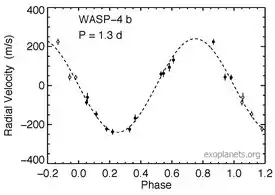WASP-4b
WASP-4b is an extrasolar planet approximately 891 light-years away[5] in the constellation of Phoenix.[6]
 Size comparison of WASP-4b with Jupiter. | |
| Discovery[1][2] | |
|---|---|
| Discovered by | Wide Angle Search for Planets |
| Discovery site | South African Astronomical Observatory |
| Discovery date | October 31, 2007 |
| Transit photometry | |
| Orbital characteristics | |
| 0.02255+0.00095 −0.00065[3] AU | |
| Eccentricity | 0.0[3] |
| 1.3382324+0.0000017 −0.0000029[3] d | |
| Inclination | 89.35+0.64 −0.49[3] |
| Semi-amplitude | 247.6+13.9 −6.8[3] |
| Star | WASP-4 |
| Physical characteristics | |
Mean radius | 1.304+0.054 −0.042[3] RJ |
| Mass | 1.21+0.13 −0.08[3] MJ |
| Temperature | 1900±100[4] |
Discovery
The planet was the discovered by the Wide Angle Search for Planets team using images taken with the SuperWASP-South projects eight wide-angle cameras located at the South African Astronomical Observatory.[7][1] Analysis of over 4000 images taken between May and November 2006 resulted in the detection of a transit occurring every 1.3 days. Follow-up radial velocity observations using the Swiss 1.2-metre Leonhard Euler Telescope confirmed that the transiting object was a planet.[1]

Characteristics
The equilibrium planetary temperature would be 1650±30 K,[3] but measured temperature is higher at 1900±100 K.[4] Dayside temperature measured in 2020 is 1957±68 K.[8]
The study in 2012, utilizing a Rossiter–McLaughlin effect, have determined the planetary orbit is probably aligned with the equatorial plane of the star, misalignment equal to -1+14
−12°.[9]
References
- Wilson, D. M.; et al. (2008). "WASP-4b: A 12th Magnitude Transiting Hot Jupiter in the Southern Hemisphere". The Astrophysical Journal Letters. 675 (2): L113–L116. arXiv:0801.1509. Bibcode:2008ApJ...675L.113W. doi:10.1086/586735.
- "Astronomer discovers new planets". BBC News. 2007-10-31. Retrieved 2018-09-23.
- Table 3, Improved parameters for the transiting hot Jupiters WASP-4b and WASP-5b, M. Gillon et al., Astronomy and Astrophysics 496, #1 (2009), pp. 259–267, doi:10.1051/0004-6361:200810929, Bibcode:2009A&A...496..259G.
- Zhou, G.; Bayliss, D. D. R.; Kedziora-Chudczer, L.; Tinney, C. G.; Bailey, J.; Salter, G.; Rodriguez, J. (2015). "Secondary eclipse observations for seven hot-Jupiters from the Anglo-Australian Telescope". Monthly Notices of the Royal Astronomical Society. 454 (3): 3002–3019. arXiv:1509.04147. Bibcode:2015MNRAS.454.3002Z. doi:10.1093/mnras/stv2138.
- Brown, A. G. A.; et al. (Gaia collaboration). "Gaia Early Data Release 3: Summary of the contents and survey properties". Astronomy & Astrophysics (in press). arXiv:2012.01533. doi:10.1051/0004-6361/202039657. S2CID 227254300. Gaia EDR3 record for this source at VizieR.
- Roman, Nancy G. (1987). "Identification of a Constellation From a Position". Publications of the Astronomical Society of the Pacific. 99 (617): 695–699. Bibcode:1987PASP...99..695R. doi:10.1086/132034. Vizier query form
- Sherriff, Lucy (2007-10-31). "UK boffins ID three new exo-planets". The Register. Retrieved 2018-09-23.
- Systematic phase curve study of known transiting systems from year one of the TESS mission, 2020, arXiv:2003.06407
- Obliquities of Hot Jupiter host stars: Evidence for tidal interactions and primordial misalignments, 2012, arXiv:1206.6105
External links
![]() Media related to WASP-4b at Wikimedia Commons
Media related to WASP-4b at Wikimedia Commons
- "Transiting exoplanets from the Wide Angle Search for Planets". WASP Planets. Coel Hellier. Retrieved 2020-12-27.
- "UK planet hunters announce three new finds" (PDF). 2007-10-30. Archived from the original (PDF) on 2008-05-16. Retrieved 2008-07-02.
